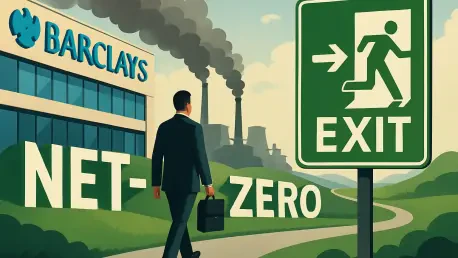In a striking move that has reverberated through the financial and environmental sectors, Barclays, a leading British bank, has announced its withdrawal from the United Nations-backed Net-Zero Banking Alliance (NZBA), a coalition dedicated to achieving net-zero emissions by 2050. This decision comes on the heels of similar exits by other major financial institutions, spotlighting a growing tension between sustainability commitments and the practical realities of global banking. The departure raises pressing questions about the future of collective climate action within the industry, especially as political and economic pressures mount. With Barclays citing a significant decline in the alliance’s membership as a key factor, this development reflects broader challenges facing banks striving to balance environmental goals with operational demands. As the financial sector navigates an increasingly complex landscape, understanding the motivations and implications of such a move becomes essential for stakeholders across the board.
Understanding the Broader Context of Climate Alliances
Membership Decline and Its Ripple Effects
The Net-Zero Banking Alliance, once seen as a cornerstone for aligning financial activities with global climate goals, has experienced a notable erosion of its membership in recent times, with Barclays being the latest to step away. This trend is not isolated, as several global and U.S.-based banks have also distanced themselves from such coalitions, often pointing to diminishing effectiveness due to reduced participation. Barclays explicitly noted that the alliance “no longer has the membership to support our transition,” highlighting a critical tipping point where the collective strength of the group falters. This exodus is influenced by external factors, including political scrutiny in regions like the United States, where Republican-led criticism has intensified against climate-focused initiatives. The shifting political landscape, coupled with changes in federal leadership, has created an environment where banks face heightened pressure to reassess their involvement in such alliances, raising concerns about the viability of coordinated climate action.
Political and Economic Pressures Shaping Decisions
Beyond membership decline, the decision by Barclays to exit the NZBA underscores the significant impact of geopolitical and economic dynamics on corporate sustainability strategies. In many regions, particularly the U.S., banks encounter growing resistance from policymakers who view climate commitments as conflicting with economic priorities. This tension is compounded by the operational challenges of aligning vast financial portfolios with net-zero targets while maintaining profitability and shareholder confidence. For Barclays, navigating these pressures means balancing public commitments to sustainability with the realities of a polarized global landscape. The broader trend of withdrawals suggests a consensus among financial giants that such alliances may not offer sustainable frameworks under current conditions. This situation prompts a deeper examination of how banks can pursue environmental goals independently or through alternative mechanisms, especially when collective efforts face systemic obstacles that hinder progress.
Implications of Barclays’ Strategic Shift
Commitment to Sustainability Amid Controversy
Despite stepping back from the NZBA, Barclays has reiterated its dedication to achieving net-zero emissions by 2050, a target that remains central to its long-term vision. The bank has also pledged to allocate $1 trillion in sustainable and transition financing by 2030, signaling a robust intent to support a low-carbon economy. Recent achievements further bolster this narrative, with Barclays reporting £500 million in revenue from sustainable and low-carbon activities in the latest financial year, alongside facilitating £508 million in climate technology investments through its dedicated arm over recent years. However, this public stance on sustainability is juxtaposed against criticism from environmental groups, creating a complex picture. The bank’s ongoing efforts to invest in green initiatives demonstrate a commitment to transition, yet the exit from a key alliance raises questions about the depth of its alignment with collective climate goals in the face of external challenges.
Criticism and Contradictions in Environmental Impact
Contrasting with Barclays’ sustainability claims, a recent report from a coalition of climate organizations, including prominent groups like the Rainforest Action Network and Sierra Club, paints a starkly different picture of the bank’s environmental footprint. Identified as the largest financier of fossil fuels in Europe for the prior year, Barclays increased its funding in this sector by over 55%, reaching $35.4 billion. This places the bank among global leaders like JPMorgan Chase and Citi, which have similarly escalated fossil fuel investments. Such actions stand in sharp contrast to the bank’s net-zero rhetoric, drawing sharp criticism from advocacy groups. ShareAction, a U.K.-based responsible investment NGO, described the withdrawal from NZBA as “incredibly disappointing,” emphasizing the inconsistency in messaging, especially as Barclays reaffirmed its climate goals just days before the exit. This duality fuels a narrative of mixed signals, complicating trust among stakeholders and highlighting the intricate balance between environmental pledges and business practices.
Reflecting on a Pivotal Moment for Financial Climate Action
Lessons Learned from a Shifting Landscape
Looking back, Barclays’ departure from the Net-Zero Banking Alliance marked a critical juncture for the financial sector’s engagement with climate initiatives. It underscored the fragility of collective action when faced with dwindling participation and mounting external pressures. The bank’s decision, alongside similar moves by peers, reflected a broader reevaluation of how sustainability commitments could be pursued amid political and economic headwinds. Critics pointed to the glaring discrepancies between Barclays’ substantial fossil fuel financing and its green rhetoric, a tension that mirrored challenges across the industry. This moment served as a reminder that aligning vast financial operations with ambitious environmental targets was no straightforward task, often requiring navigation through a maze of conflicting priorities and stakeholder expectations.
Charting a Path Forward for Sustainable Banking
As the dust settled on Barclays’ exit, attention turned to actionable steps for the future of sustainable banking. Financial institutions could explore alternative frameworks or bilateral partnerships to advance climate goals outside the constraints of large alliances. Emphasizing transparency in reporting environmental impacts, particularly in fossil fuel investments, emerged as a vital consideration to rebuild trust with stakeholders. Additionally, leveraging technology and innovation to drive green financing offered a promising avenue for banks to demonstrate commitment. For Barclays and others, the challenge lay in crafting strategies that reconciled operational realities with the urgent need for climate action. Engaging with policymakers to shape supportive regulatory environments could further enable progress, ensuring that the pursuit of a low-carbon economy remained a feasible and impactful endeavor for the sector at large.









